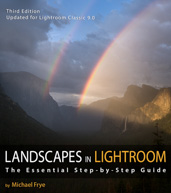In the Moment:
Michael Frye's Landscape Photography Blog
by Michael Frye | Jun 12, 2016 | Composition
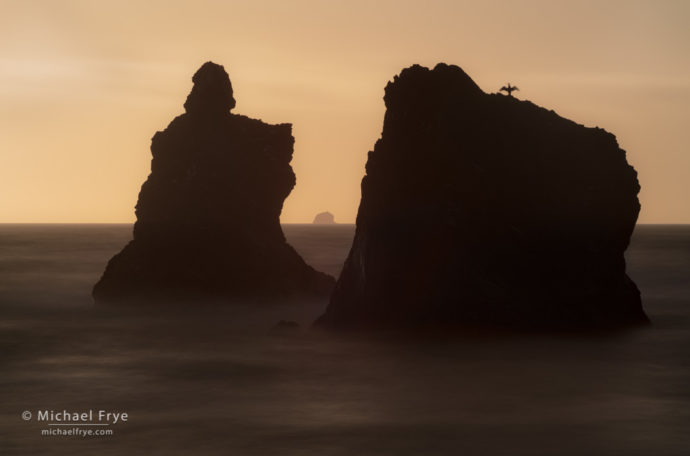
Sea stacks and cormorant, Redwood NP, CA, USA
Separating visual elements is a concern in any composition, but seems to be particularly vital when photographing the ocean and forest scenes along the northern California coast. Both sea stacks and redwood trunks need to be well-spaced, balanced, and stand out clearly.
(more…)
by Michael Frye | Jun 7, 2016 | Light and Weather
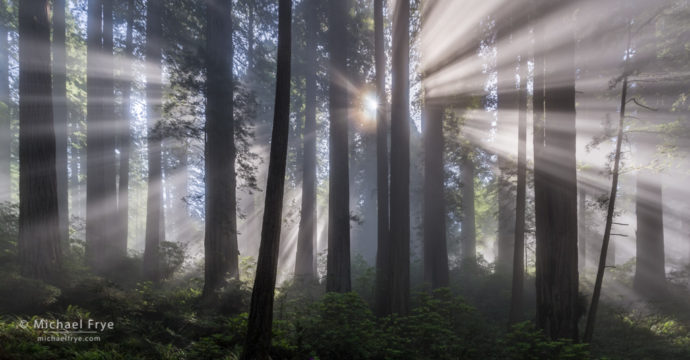
Sunbeams in a redwood forest along the northern California coast
Before our workshop last week we found fog along the Klamath River, and valley fog in some meadows, but none of the coastal fog that typically envelops the California coast in summer. The coastal fog is much more widespread than the other types of fog, and it’s the only kind of fog that gets thick enough and high enough to penetrate into the redwood forests. That coastal fog typically forms when it’s hot inland, but temperatures just hadn’t reached summer levels yet.
(more…)
by Michael Frye | May 29, 2016 | Light and Weather
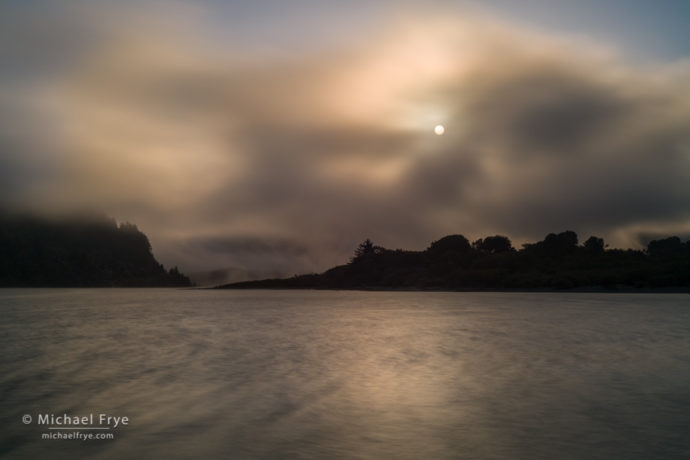
Foggy sunrise along the Klamath River, Redwood NP, CA, USA
(more…)
by Michael Frye | May 22, 2016 | Yosemite Photo Conditions

Ice and reflections in Ellery Lake, Inyo NF, Wednesday evening
Tenaya Lake was totally free of ice, while Tioga Lake was almost completely frozen. Ellery Lake just right, with a photogenic mixture of ice and open water. But I’m sure that will all melt soon, while Tioga Lake should be getting more open patches of water.
Meanwhile, the park did get some showers on Friday and Saturday, with a dusting of high-elevation snow. The Tioga Road has been closed off and on since Friday night, though as I write this it’s open. With showers in the forecast over the next few days it’s possible that the road may close again temporarily.
(more…)
by Michael Frye | May 19, 2016 | Advanced Techniques, Night Photography
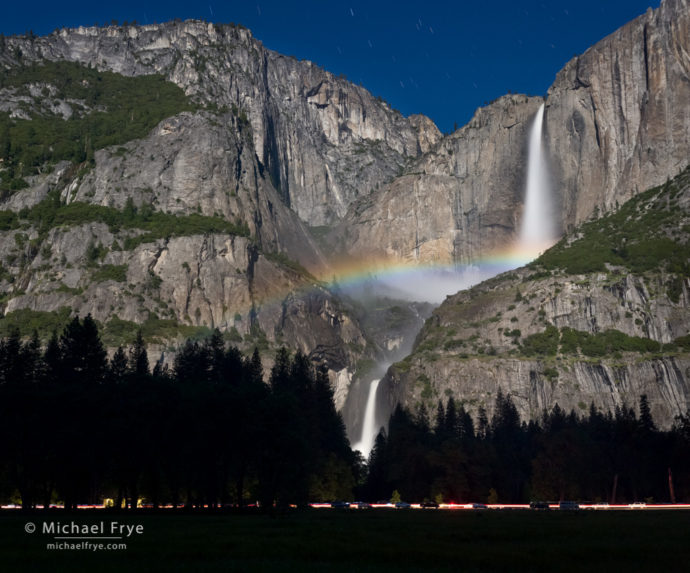
Lunar rainbow from Cook’s Meadow, Yosemite; from June, 2011, a very wet year
Lunar Rainbows and the Milky Way
There will be a full moon this Saturday, and I’m sure many photographers will be heading to Yosemite to photograph the lunar rainbow. Astronomer and “Celestial Sleuth” Don Olson has updated his website to include predictions for when the moonbow will appear on Upper Yosemite Fall from Cook’s Meadow, in addition to his previous predictions for Lower Yosemite Fall.
I think there should be enough spray to make the rainbow visible on Upper Yosemite Fall this month, but probably not in June, when there will be less spray. The Lower Yosemite Fall bridge might work in June, because you don’t need as much water to see a rainbow from that spot, but I expect the bridge will be rather wet this month, which will make it hard to keep spray off the front of your lens. Of course the weather always plays a role, and there are showers in the forecast for this Friday and Saturday nights, so the moonlight might get blocked by clouds. But if you want to try your hand at either location, here are some tips for photographing lunar rainbows.
This is also the beginning of Milky Way season here in the northern hemisphere. The brightest part of the Milky Way can now be seen rising just after 10:30 p.m. here in central California, and will be visible in the evening sky through September.
(more…)
by Michael Frye | May 18, 2016 | Yosemite Photo Conditions
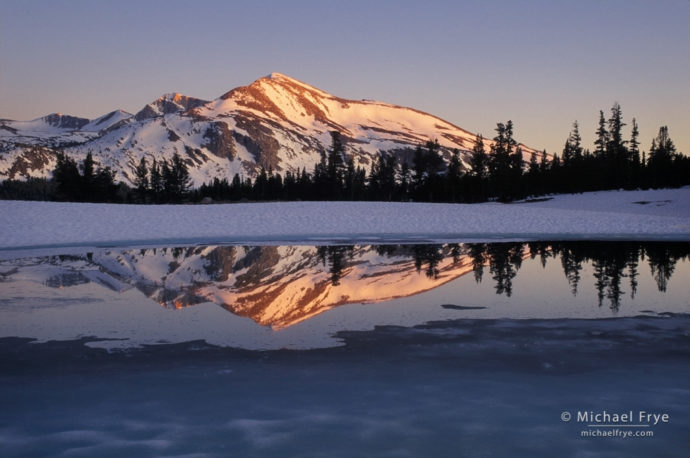
Mammoth Peak reflected in snowmelt pond, near Tioga Pass, Yosemite, from 1993
— Michael Frye
(more…)
by Michael Frye | May 17, 2016 | Announcements
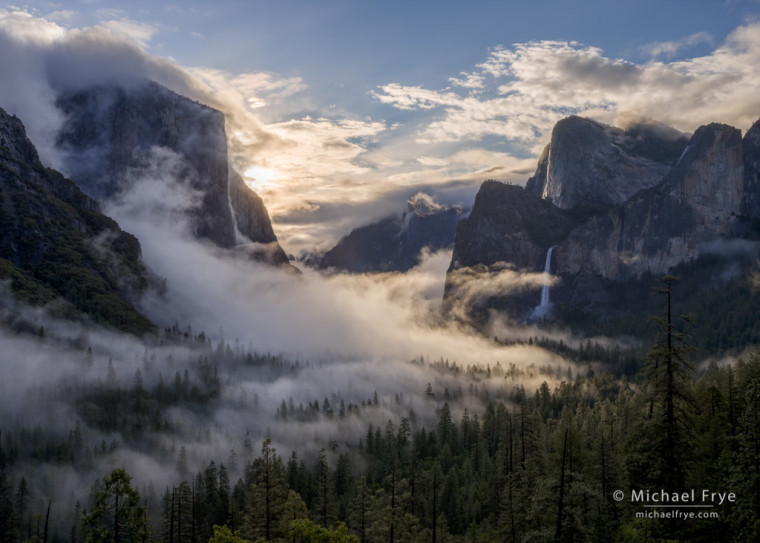
Swirling mist from Tunnel View, Yosemite
The Ansel Adams Gallery is located next to the Yosemite Valley Visitor Center in Yosemite Village. Summer hours are 9:00 a.m. to 6:00 p.m., seven days a week. If you’re in Yosemite during June or July I hope you’ll stop by the Gallery and see the exhibit. Or maybe the show will give you another excuse to visit the park – as if you needed one!
— Michael Frye
(more…)
by Michael Frye | May 11, 2016 | Advanced Techniques, Digital Darkroom, Yosemite Photo Conditions
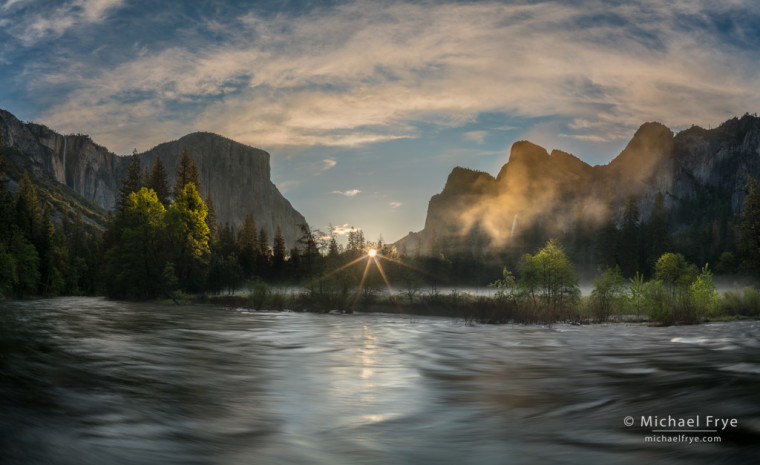
Spring sunrise, Gates of the Valley, Yosemite, Sunday morning
First, to my subscribers, thanks for your understanding about the email glitches yesterday. I really appreciate all the supportive emails so many people sent. Your kind words turned a frustrating day into a great one.
I haven’t posted anything new on the blog for awhile because I was teaching a workshop, and then working on our new website. The new site is still a bit of a work in progress, so if you find any broken links or other issues please let me know. But the new site better integrates the blog with the other content, makes it easier to add and update portfolios, and will work much better with phones and tablets, so I hope it will be a better experience for everyone.
Meanwhile we had a great workshop, with flowing waterfalls, fresh spring greenery, dogwoods, and some interesting weather and clouds. And the cool, showery spring weather has continued, which I love. I’m not ready for the summer heat, and always happy to have clouds and mist to photograph.
(more…)
by Michael Frye | Apr 24, 2016 | Yosemite Photo Conditions
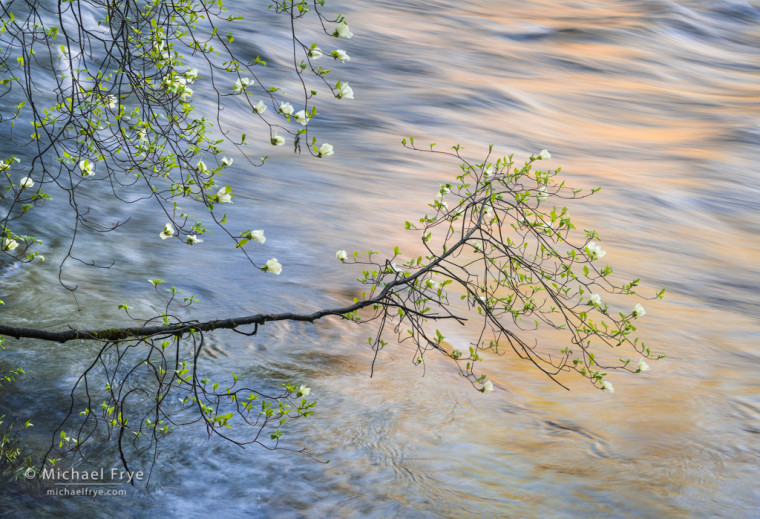
Morning reflections, dogwood and the Merced River, Yosemite NP, CA, USA
We had a nice spring storm on Friday. Here in Mariposa we heard some loud thunder, and experienced a torrential downpour for about ten minutes. We got about half and inch of rain altogether, but Yosemite Valley got an inch and a third, which is a big total for April. Snow fell on the rim of the valley, and the Glacier Point Road, which had opened on Tuesday, was closed again temporarily.
The storm cleared after sunset on Friday, and Claudia and I drove up to Yosemite Valley early on Saturday morning, hoping for mist. There wasn’t much mist, but we found some dogwoods in a small patch of fog near the base of Middle Cathedral Rock, which kept me busy for awhile. Later, as the sun started to reach down into the valley, I photographed more dogwoods against the background of the Merced River, with golden reflections in the water.
(more…)
by Michael Frye | Apr 17, 2016 | Night Photography, Travels and Stories, Yosemite Photo Conditions
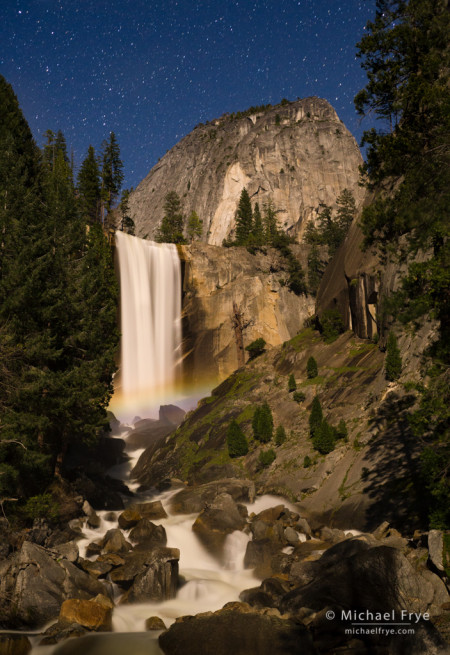
Vernal Fall and Liberty Cap at night with a lunar rainbow, Yosemite. 20 seconds at f/4, ISO 6400
Claudia and I made a nighttime trip up the Mist Trail recently. The ostensible purpose of this hike was to look for lunar rainbows, and we did find some, as you can see from the photos. But that was just a bonus. The real reward was being up there on a beautiful, moonlit night, with the roar of the falling water filling our ears, and having this normally-crowded trail completely to ourselves. It was so much fun.
The moon will be full on Thursday night, and with the good water flow this spring I expect that many photographers will be making their way to Yosemite to photograph lunar rainbows on Yosemite Falls. Don Olson has posted lunar rainbow predictions for Lower Yosemite Fall, but the spray will be soaking the bridge below the lower fall, making it hard to keep lenses dry during long exposures. Unfortunately Don hasn’t posted any predictions yet for Upper Yosemite Fall, and my trigonometry skills aren’t good enough to make those predictions myself. I think lunar rainbows will be visible on the upper fall from Cook’s Meadow at some point on Thursday evening, and the following couple of nights, but I can’t be positive!
(more…)

















